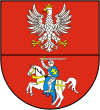Białystok
- See also: Białystok, Lublin Voivodeship
| Białystok | |||
|
|
|||
|
|||
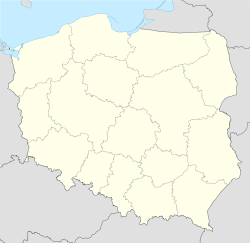 Białystok
|
|||
| Coordinates: | |||
| Country | |||
|---|---|---|---|
| Voivodeship | Podlaskie | ||
| County | city county | ||
| Established | 14th century | ||
| Town rights | 1692 | ||
| Government | |||
| - Mayor | Tadeusz Truskolaski | ||
| Area | |||
| - City | 102.12 km² (39.4 sq mi) | ||
| Highest elevation | 160 m (525 ft) | ||
| Lowest elevation | 120 m (394 ft) | ||
| Population (2006) | |||
| - City | 295,210 | ||
| - Density | 2,890.8/km² (7,487.2/sq mi) | ||
| - Metro | 370,000 | ||
| Time zone | CET (UTC+1) | ||
| - Summer (DST) | CEST (UTC+2) | ||
| Postal code | 15-001 | ||
| Area code(s) | +48 85 | ||
| Car plates | BI | ||
| Website: http://www.bialystok.pl | |||
Białystok [bʲaˈwɨstɔk] (![]() listen) (also known by alternative names) is the largest city in northeastern Poland. It is located near Poland's border with Belarus and is the historical capital of the Podlachia region. In 2006, its population was 294,830. From 1921 to 1998, it lay within Białystok Voivodeship; since 1999, it has been the capital of Podlaskie Voivodeship.
listen) (also known by alternative names) is the largest city in northeastern Poland. It is located near Poland's border with Belarus and is the historical capital of the Podlachia region. In 2006, its population was 294,830. From 1921 to 1998, it lay within Białystok Voivodeship; since 1999, it has been the capital of Podlaskie Voivodeship.
Contents[hide] |
Names
According to legend, Białystok was given its name by the Grand Duke of Lithuania Gediminas ca. 1320. An English translation of Białystok would be "white slope" or "clean stream" (in Old Polish language). The city has been known in Belarusian as Беласток (Biełastok, IPA: [bʲeɫa'stok]), in Lithuanian as Balstogė (White roof in Lithuanian), and in Yiddish as ביאַליסטאָק (Byalistok, Bjalistok). It has been known in Russian as Белосток or Belostok, a variant also used sometimes in English.
History

The first mention of the place in historical sources dates from 1437 when the land around the Biala river (which is called "Bialka" by inhabitants) was given by Grand Duke of Lithuania Casimir IV Jagiellon to Raczko Tabutowicz, then in 1547 it passed to the Wiesiołowski family. They built a brick castle and a church here. It was then a part of the Grand Duchy of Lithuania. In 1645 after the death of Krzysztof Wiesiołowski, the last of the clan, Białystok became the property of the Commonwealth. In 1661 it was given to Stefan Czarniecki as a reward for his service in the victory over the Swedes. Four years later, as a dowry of his daughter Aleksandra, it passed to the Branicki family.
In the second half of the 18th century Field Crown Hetman Jan Klemens Branicki, a commander in chief, became the heir of the Białystok area. It was he who transformed the previously existing abode into the magnificent residence of a great noble. Several artists and scientists came to Białystok to take advantage of Branicki's patronage. Białystok received its city charter in 1749.
After the third partition of the Polish-Lithuanian Commonwealth in 1795 it first belonged to the Prussian Kingdom, then after the Peace of Tilsit signed in 1807 it passed to Russia. During the 19th century the city became a major centre of textile industry. Due to an industrial boom the population grew from 13,787 in 1857, and 56,629 in 1889, to 65,781 in 1901. At this time, the majority of the city's population was Jewish.
After the outbreak of the First World War in 1914, the first heavy bombing of the town took place on 20 April 1915. On 13 August 1915 German soldiers appeared in Białystok. The city was included in the Ober Ost occupational region. In March of 1918 it was declared part of the Belarusian National Republic; in July of 1918 it was made part of Lithuanian Province and became capital of the Southern Lithuania government precinct. On February 19, 1919 the city was taken by Poland. In 1920, when overrun by Soviet forces during the Polish-Soviet War, it briefly served as headquarters of the Polish Revolutionary Committee headed by Julian Marchlewski, which attempted to declare the Polish Soviet Socialist Republic.

In the years 1920–1939, the city was again part of independent Poland. In September 1939, Białystok was occupied by the German army, but then passed on to the Soviet Union with respect to the secret protocol of the Molotov-Ribbentrop pact, when it was annexed into the Byelorussian SSR. The Belastok Voblast with the centre in Bielystok was created in 1939.
On June 27, 1941, Białystok fell into Nazi hands as a result of the invasion of the Soviet Union. From the very beginning, the Nazis pursued a ruthless policy of pillage and extermination of the non-German population. The 56,000 Jewish members of the town were confined in a ghetto, which during August 1941 was exterminated. On the morning of June 27, 1941, Nazi troops from Order Police Battalion 309[1] surrounded the town square by the Great Synagogue (the largest wooden synagogue in Eastern Europe), and forced residents from their homes into the street. Some were shoved up against building walls and shot dead. Others – some 800 men, women and children – were locked in the synagogue, which was subsequently set on fire; there they burned to death. The Nazi onslaught continued with the grenading of numerous homes and further shootings. As the flames from the synagogue spread and merged with the grenade fires, the entire square was engulfed. On that day – June 27, 1941 – some 3,000 Jews lost their lives.[2]
In the last year of the occupation, a clandestine upper Commercial School came into existence. The pupils of the school also took part in the underground resistance movement. As a result, some of them were jailed, some killed and others deported to concentration camps.
A number of anti-fascist groups came into existence in Białystok during the first weeks of the occupation. In the following years, there developed a well-organized resistance movement.
On August 15, 1943, the Białystok Ghetto Uprising began, and several hundred Polish Jews started an armed struggle against the German troops who were carrying out the planned liquidation of the ghetto.
Ecclesiastical history
For most of its existence, Białystok was part of the diocese of Vilna, the Lithuanian capital.
Only on June 5, 1991, was the diocese of Białystok (Latin rite) bishopric established. On March 25, 1992, it was promoted as Metropolitan Archdiocese of Białystok with two Suffragan dioceses: Drohiczyn (also established in 1991) and Łomża (established on March 25, 1798 as the Diocese of Sejny / Augustów / Sejna).
Education


- Białystok University (Uniwersytet w Białymstoku)
- Białystok Technical University (Politechnika Białostocka)
- Medical University of Białystok (Akademia Medyczna w Białymstoku)
- Białystok School of Public Administration (Wyższa Szkoła Administracji Publicznej)
- Białystok Institute of Cosmetology (Wyższa Szkoła Kosmetologii w Białymstoku)
- Academy of Economics in Białystok (Wyższa Szkoła Ekonomiczna w Białymstoku)
- Academy of Finance and Management in Białystok (Wyższa Szkoła Finansów i Zarządzania w Białymstoku)
- Musical Academy in Białystok (Akademia Muzyczna w Białymstoku) http://chopin.man.bialystok.pl
- Akademia Teatralna http://puppet.man.bialystok.pl
- Archidiecezjalne wyższe Seminarium Duchowne http://www.awsd.bialystok.pl
- Instytut Nauk Politycznych (Filia w Białymstoku) http://www.wsd.com.pl/moduly/artykuly/index.php
- Wyższa Szkoła Matematyki i Informatyki Użytkowej http://wsmiiu.edu.pl/
- Nauczycielskie Kolegium Rewalidacji i Resocjalizacji http://www.nkrr.bialystok.pl
- Niepaństwowa Wyższa Szkoła Pedagogiczna http://www.nwsp.bialystok.pl
- Wyższa Szkoła Gospodarowania Nieruchomościami (Filia w Białymstoku) http://www.wsgn.pl
- Papieski Wydział Teologiczny (Studium Teologii)
- Wyższa Szkoła Menedżerska http://www.wsm.pl
- Niepubliczne Nauczycielskie Kolegium Języków Obcych
- Nauczycielskie Kolegium Języków Obcych "Inter - Lingua" http://www.nkjo.bialystok.pl
Politics
Białystok constituency

Members of Parliament (Sejm) elected from Białystok constituency:
- Borawski, Edmund: PSL
- Cimoszewicz, Włodzimierz: SLD-UP
- Ciruk, Barbara: SLD-UP
- Czerniawski, Mieczysław: SLD-UP
- Czuż, Aleksander: SLD-UP
- Czykwin, Eugeniusz: SLD-UP
- Fedorowicz, Andrzej: LPR
- Jurgiel, Krzysztof: PiS
- Kamiński, Michał: PiS
- Krutul, Piotr: LPR
- Laskowski, Józef: Samoobrona
- Mioduszewski, Józef: PSL
- Wiśniowska, Genowefa: Samoobrona
- Zagórski, Marek: PO
- Zaworski, Jan: SLD-UP
- Zieliński, Jarosław: PiS
Municipal politics
Administrative division

The City of Białystok is divided into 28 districts:
- Centrum
- Białostoczek
- Sienkiewicza
- Bojary
- Piaski
- Przydworcowe
- Młodych
- Antoniuk
- Jaroszówka
- Wygoda
- Piasta I
- Piasta II
- Skorupy
- Mickiewicza
- Dojlidy
- Bema
- Kawaleryjskie
- Nowe Miasto
- Zielone Wzgórza
- Starosielce
- Słoneczny Stok
- Leśna Dolina
- Wysoki Stoczek
- Dziesięciny I
- Dziesięciny II
- Bacieczki
- Zawady
- Dojlidy Górne
Monuments

- In memory of victims of the Polish-Bolshevik war - Picture
- "42nd Infantry Regiment" of Jan Henryk Dabrowski monument - Picture
- Armia Krajowa monument - Picture
- In memory of heroes from Białystok Land in WWII - Picture
- Jadwiga Dziekońska (soldier of Armia Krajowa) monument - Picture
- In memory of murdered Poles in Katyn - Picture
- Marshal Józef Piłsudski monument - Picture
- Jerzy Popiełuszko monument - Picture
- Polish Army in western Europe (during WWII) monument - Picture
- Solidarność monument - Picture
- In memory of Poles deported to Siberia - Picture
- In memory of murdered Jews in the Great Synagogue (WWII) - Picture
- In memory of victims of the Ghetto uprising in Białystok - Picture
- Defenders of Białystok monument (WWII) - Picture
- Ludwik Zamenhof monument - Picture
Historical population
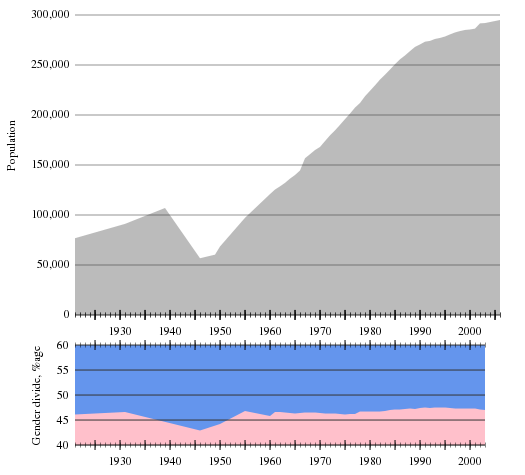
Famous people


Birthplace
- Sala Burton (née Galante), United States Representative from California.
- Tomasz Bagiński (The Cathedral).
- Hermann Friedmann, philosopher.
- Ryszard Kaczorowski, last emigré President of the Republic of Poland.
- Boris Kaufman
- Dziga Vertov (Kaufman), a Soviet documentary film and newsreel director.
- Maxim Litvinov (Wallach-Finkelstein).
- Albert Sabin, co-developer of the polio vaccine.
- Izabella Scorupco (Skorupko), actress.
- Ephraim Urbach, Talmud scholar and recipient of the Israel Prize.
- Max Weber, artist.
- L. L. Zamenhof, the creator of Esperanto.
- Abraham b. Eliezer Lipman Liechtenstein, rabbi, author and talmudic scholar.
- Michael Marks, co-founder of Marks & Spencer.
- Maciek Korbut, tattoo skateboarder.
Sports
- Hetman Białystok
- Jagiellonia Białystok, football team (Orange Ekstraklasa 2007/2008).
- Rowerowy Białystok, cycling association, PTR Dojlidy – MTB Sport Team [1].
Cultural references
- The asteroid 19981 Bialystock was named in the city's honour on 1 June 2007.†
- The bialy, a bagel-like roll, derives its name from the city.
- The protagonist of Mel Brooks' film and musical The Producers is named Max Bialystock.
- In the 1995 computer game Command & Conquer, the Brotherhood of Nod manipulates the global media into believing that Bialystok and all of its inhabitants were slaughtered by GDI forces. The city was spelled "Byelistok" in the game.
- A large part of the narrative of David Zagier's early memoirs, Botchki, centres on Bialystok.
Twin towns
Białystok is twinned with the following cities and towns:
 Częstochowa, Poland
Częstochowa, Poland Dijon, France
Dijon, France Eindhoven, Netherlands
Eindhoven, Netherlands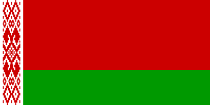 Hrodna, Belarus
Hrodna, Belarus Jelgava, Latvia
Jelgava, Latvia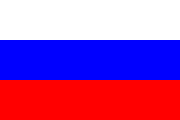 Kaliningrad, Russia
Kaliningrad, Russia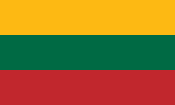 Kaunas, Lithuania
Kaunas, Lithuania Milwaukee, United States
Milwaukee, United States
See also
- Branicki Palace
- Krzysztof Kononowicz
- Max Bialystock
Sources and external links
- History of Bialystok
- Bialystoker Synagogue in New York City
- We Remember Jewish Bialystok!
- Giga-Catholic
- Catholic Encyclopaedia- Vilna
- VisitBiałystok.com
- (Polish) Archdiocesan website
- (English)(Polish) Bialystok's official website
- Michał Hoffman fotograf Białystok
- Historic images of Bialystok
- Polish Skyscrapers - Bialystok
- Podlasie & Białystok Transport
- Official Site Białystok City Transport
- Google Transit in Białystok
- (English) Transit Trip Planner in Bialystok using Google Transit algorithm
- (Polish) Jewish Heritage Trail in Bialystok
References
- ↑ Goldhagen, Daniel J. Hitler's Willing Executioners: Ordinary Germans and the Holocaust New York, NY: Vintage Books, 1997
- ↑ ::::The Importance of World Peace: The Holocaust::::
|
|||
|
|||
|
|||


